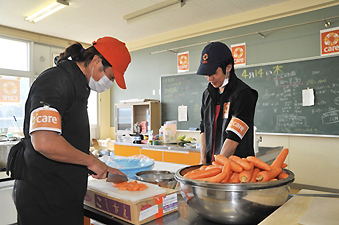
[ 2011.9. 9 ]
Six months after the enormous earthquake and tsunami that resulted in massive destruction in the North of Japan, CARE continues to provide support for communities recovering from the disaster. On March 11 a magnitude 9.0 earthquake struck near the northeast coast of Honshu and triggered devastating tsunami waves that caused extensive and severe damage. 106,858 buildings were completely destroyed, with many still to be counted. An area of 451 km2 was flooded by the tsunami.

CARE provided approximately 45,000 nutiritious meals to people in evacuation centers in Iwate prefecture between April 1 and June 30.
Soon after the tsunami hit, CARE Japan organized a convoy to the city of Kamaishi in Iwate prefecture, one of the worst-hit areas, and handed out relief items. Iwate prefecture later became CARE's primary focal area, where approximately 25,500 people sought refuge in 373 evacuation centers. As part of our immediate response efforts, CARE provided hot meals, fruit and emergency supplies including blankets, mattresses, materials for partially damaged homes and evacuation centers. Since June, psychosocial support has helped survivors to cope with their experiences.
Food and relief items
In April, CARE provided 16,190 breakfast and dinner meals to people at the Yamada Minami elementary school and surrounding evacuation centers in Iwate prefecture. Before the meal program started, families would often only share a rice ball and bowl of miso soup for their daily meal. As most families lost their possessions during the tsunami, CARE also distributed emergency supplies to those living in evacuation centers and in their damaged houses. These items included 270 sets of mattresses & covers, 18,000 summer blankets, pans, plates, utensils, soap, shampoo, towels and small toiletries.
In Otsuchi town CARE started to cooperate with the local market, where store owners, whose buildings had been destroyed by the tsunami, could sell food items. CARE provided 26 plastic shades to protect the market from the strong sun. In Yamada town CARE introduced a voucher system for food and relief items and supports the reconstruction of nine restaurants and shops in the city centre.
Psychosocial support and education
Six months have passed since the earthquake and tsunami. Still, the psychosocial effects of the disaster remain present. Many of the survivors are struggling to overcome the events of March 11. Across the affected region, banners on buildings, buses and taxis motivate the survivors to ganbarou - encourage them to overcome the challenges.
CARE is helping to rebuild and strengthen social networks by supporting community newsletters, community cafes, and local festivals. In the community cafes people can meet, chat and get to know each other. This is particularly important for elderly people who find it difficult to adjust to their new surroundings. The newsletters and community newspapers provide important and useful information for people living in evacuation centers about where to receive food, medical support and other services. CARE also supports a theatre group staging performances for children in Miyako town.
Schools have been particularly hard-hit by the catastrophe. Education is very important for children to structure their every day routine and to have a sense of belonging and perspective. CARE supports Otsuchi Junior High School with school uniforms, supplies and other extracurricular activities. In Miyako, CARE provided a generator and cutter ships for the local Fishery High School to help restart vocational training. For the Miyako Industrial High School CARE will provide equipment for club activities and sports.
The road ahead
There are signs of hope. Key transportation infrastructure has been restored and all airports are now operating. The debris in the affected areas is being cleared away day by day. Over the recent months, the number of people in evacuation centers has significantly decreased as more permanent shelters have been constructed. However, there are still more than 8,500 people living in 283 evacuation centers in the three worst affected areas of Iwate, Miyagi and Fukushima.
CARE will soon complete the food program, and focus more on community relief and psychosocial support to help people recover from the trauma. The needs of the people in the affected area will shift as the season changes. CARE continues to coordinate with local authorities and other aid agencies in order to identify the needs and reach the most vulnerable people.
About CARE: CARE is one of the world's largest humanitarian aid agencies, providing assistance in nearly 70 countries. CARE has been working in Israel, West Bank and Gaza since 1948 (with a short break from 1984-1994), initially implementing programs to help immigrants after the Holocaust. Today, CARE implements programs in food security, health and water, support for civil society groups, and distributions of fresh food. Since the conflict started Dec. 27, CARE has distributed fresh food, medical supplies, heaters, blankets and plastic sheeting to hospitals, families and feeding centres in Gaza.